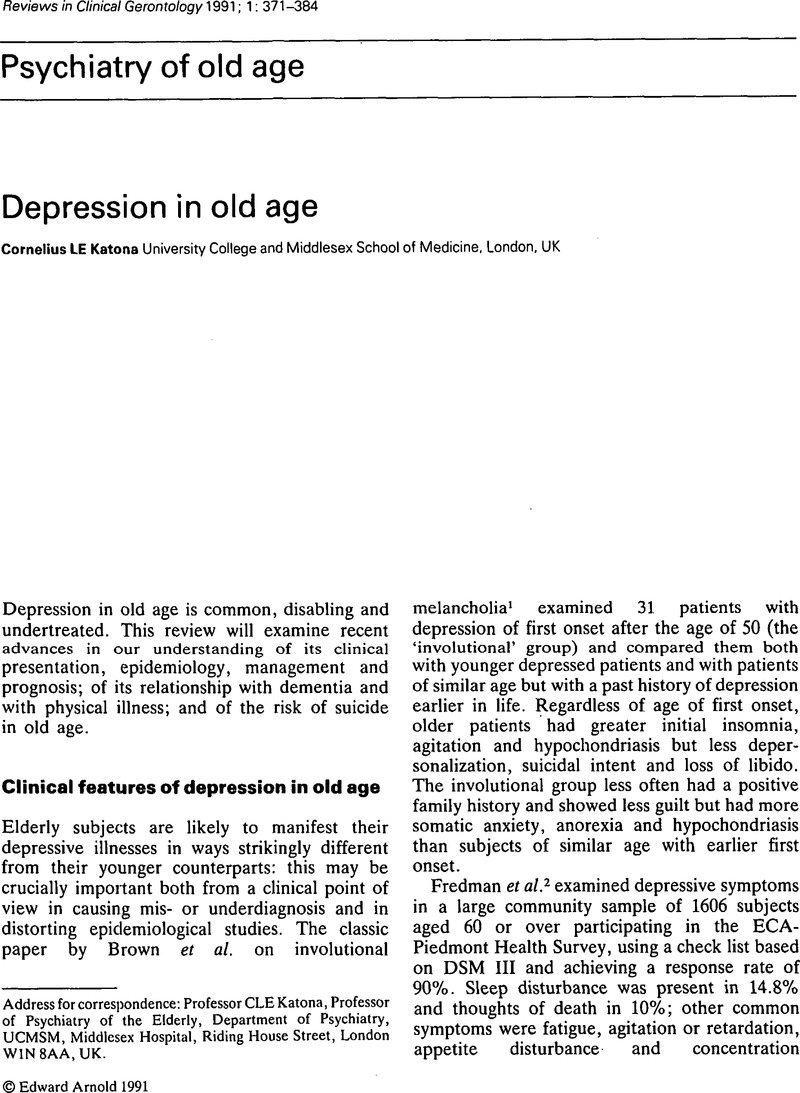Crossref Citations
This article has been cited by the following publications. This list is generated based on data provided by Crossref.
Katona, C.
1993.
Optimizing treatment for the elderly depressive: new antidepressants in the elderly.
Journal of Psychopharmacology,
Vol. 7,
Issue. 1,
p.
131.
Woods, R. T.
1993.
Psychosocial management of depression.
International Review of Psychiatry,
Vol. 5,
Issue. 4,
p.
427.
Woo, J.
Ho, S. C.
Lau, J.
Yuen, Y. K.
Chiu, H.
Lee, H. C.
and
Chi, I.
1994.
The prevalence of depressive symptoms and predisposing factors in an elderly Chinese population.
Acta Psychiatrica Scandinavica,
Vol. 89,
Issue. 1,
p.
8.
Orrell, Martin
and
Bebbington, Paul
1995.
Life Events and Senile Dementia Affective Symptoms.
British Journal of Psychiatry,
Vol. 166,
Issue. 5,
p.
613.
Halikas, James A.
1995.
Org 3770 (mirtazapine) versus trazodone: A placebo controlled trial in depressed elderly patients.
Human Psychopharmacology: Clinical and Experimental,
Vol. 10,
Issue. S2,
p.
S125.
Girling, Deborah M.
Barkley, Claire
Paykel, Eugene S.
Gehlhaar, Eric
Brayne, Carol
Gill, Caroline
Mathewson, Diane
and
Huppert, Felicia A.
1995.
The prevalence of depression in a cohort of the very elderly.
Journal of Affective Disorders,
Vol. 34,
Issue. 4,
p.
319.
Hsyøerg, O. J.
Maragakis, B.
Mullin, J.
Norum, D.
Stordall, E.
Ekdahl, P.
Ose, E.
Moksnes, K. M.
and
Sennef, C.
1996.
A double‐blind multicentre comparison of mirtazapine and amitriptyline in elderly depressed patients.
Acta Psychiatrica Scandinavica,
Vol. 93,
Issue. 3,
p.
184.
Chi, Iris
and
Chou, Kee-Lee
2000.
Financial Strain and Depressive Symptoms Among Hong Kong Chinese Elderly.
Journal of Gerontological Social Work,
Vol. 32,
Issue. 4,
p.
41.
Chou, Kee-Lee
and
Chi, Iris
2000.
Stressful Events and Depressive Symptoms among Old Women and Men: A Longitudinal Study.
The International Journal of Aging and Human Development,
Vol. 51,
Issue. 4,
p.
275.
Chou, Kee-Lee
Chi, Iris
and
Boey, Kam Weng
2000.
Determinants of Depressive Symptoms Among Elderly Chinese Living Alone.
Clinical Gerontologist,
Vol. 20,
Issue. 4,
p.
15.
Chi, Iris
and
Chou, Kee-Lee
2001.
Social Support and Depression among Elderly Chinese People in Hong Kong.
The International Journal of Aging and Human Development,
Vol. 52,
Issue. 3,
p.
231.
Chou, Kee-Lee
and
Chi, Iris
2001.
Financial strain and depressive symptoms in Hong Kong elderly Chinese: The moderating or mediating effect of sense of control.
Aging & Mental Health,
Vol. 5,
Issue. 1,
p.
23.
Chou, Kee-Lee
and
Chi, Iris
2001.
Stressful Life Events and Depressive Symptoms: Social Support and Sense of Control as Mediators or Moderators?.
The International Journal of Aging and Human Development,
Vol. 52,
Issue. 2,
p.
155.
Da Canhota, Carlos Manuel Nogueira
and
Piterman, Leon
2001.
Depressive Disorders in Elderly Chinese Patients in Macau: A Comparison of General Practitioners' Consultations with a Depression Screening Scale.
Australian & New Zealand Journal of Psychiatry,
Vol. 35,
Issue. 3,
p.
336.
Chou, K.-L.
and
Chi, I.
2001.
Social comparison in Chinese older adults.
Aging & Mental Health,
Vol. 5,
Issue. 3,
p.
242.
Chou, Kee-Lee
and
Chi, Iris
2002.
Chronic Illness and Depressive Symptoms among Chinese Older Adults: A Longitudinal Study.
The International Journal of Aging and Human Development,
Vol. 54,
Issue. 2,
p.
159.
Chou, Kee-Lee
2005.
Assessing shyness in Chinese older adults.
Aging & Mental Health,
Vol. 9,
Issue. 5,
p.
456.
Chou, K.-L.
Yeung, F. K. C.
and
Wong, E. C. H.
2005.
Fear of falling and depressive symptoms in Chinese elderly living in nursing homes: Fall efficacy and activity level as mediator or moderator?.
Aging & Mental Health,
Vol. 9,
Issue. 3,
p.
255.
Paukert, Amber L.
Pettit, Jeremy W.
Kunik, Mark E.
Wilson, Nancy
Novy, Diane M.
Rhoades, Howard M.
Greisinger, Anthony J.
Wehmanen, Oscar A.
and
Stanley, Melinda A.
2010.
The Roles of Social Support and Self-Efficacy in Physical Health’s Impact on Depressive and Anxiety Symptoms in Older Adults.
Journal of Clinical Psychology in Medical Settings,
Vol. 17,
Issue. 4,
p.
387.



